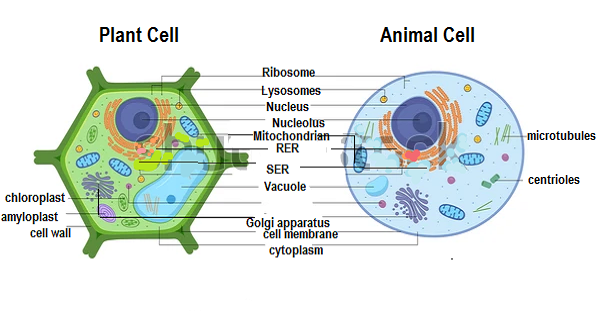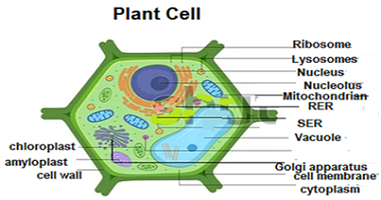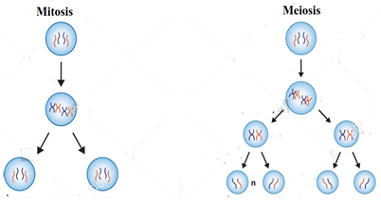Structure and Function of Cell: Cell Biology
Structure and Function of the Cell
You can study in this post,‘Structure and Function of Cell: Cell Biology’
- The basic idea of Structure and Function of Cell
- Plasma Membrane
- Transfer of the material in and out of the cell
- Hypotonic, Isotonic, and Hypertonic Solution
- The nucleus of The Cell
- Type of Cells
- Cell Organelles
- Cell Division, mitosis and meiosis
Structure and Function of Cell: Cell Biology will give you an idea about the shape, types, structures, and functions of animal and plant cells. The cell is the smallest structural and functional unit of all the life processes in living organisms, it is that’s why from birth to death of a living organism the functioning of the cell is responsible. The fusion of male and female reproductive cell form a cell of a new individual, growth of the new individual occurs due to the growth of new cells and after a certain time span, the cells start to decay resulting in all the life processes of living organism start to collapse, therefore we are needed to keep our body healthy through the exercises and yoga to combat this natural phenomenon inside our body.
Robert Hook observed the design of cork through his self-designed microscope and found it to resemble a honeycomb that consists of many little compartments. The small units the cork is made of are named ‘cell’ which means little room.Cork is an impermeable material derived from the bark tissue of the plant that is composed of hydrophobic substance suberin and used to prevent the flow of liquid.
Class 9 Science CBSE Notes
Archimedes Principle: Complete detail
Average Speed and Average velocity
The universal law of gravitational force
Thrust and Pressure : Difference
Evoporation,Vapourization and Latent heat
The invention of magnifying lenses led to the discovery of the microscopic world. It is now known that a single cell may constitute a whole organism as in Amoeba, Paramecium, and bacteria. These organisms are called unicellular organisms. On the other hand many cells group together in a single body and assume different functions in it to form various body parts in multicellular organisms such as some fungi, plants, and animals.
Click for online shopping
Future Study Point.Deal: Cloths, Laptops, Computers, Mobiles, Shoes etc
It is due to the different life processes in a living organism, the cells may be of different kinds like in human beings. The shape and size of cells are related to the specific function they perform. As all the body parts have different function, similarly cell also has different components for different functions known as cell organelles. The role of cell organelles is to build up materials required to body organs for their specific function. All the cell organelles are identical in all types of cells but they may have different functions depending on the type of cell.
Plasma Membrane: Plasma Membrane is the outermost covering of the cell that separates the contents of the cell from its external environment. The plasma membrane allows or permits the entry and exit of some materials in and out of the cell. It also prevents the movement of some other materials, it is that’s why the plasma membrane is called a selectively semipermeable membrane.
Transfer of the material in and out of the cell:
Some substances like carbon dioxide or oxygen can move across the cell membrane by a process called diffusion, this is the process in which there is the spontaneous movement of a substance from a region of high concentration to a region of low concentration. The waste product CO2 is released during the process of cellular respiration increases the concentration of CO2 inside the cell compared to the low concentration of CO2 in the external environment(CO2 in blood vessels i.e veins), the difference in concentration maintains the spontaneous flow of CO2 from inside to outside of the cell. On the same way concentration of O2 in the blood capillaries connected to the artery is higher compared to a low concentration of O2 inside the cell. The difference in concentration maintains the spontaneous flow of O2 from the outside to the inside of the cell.
Water also obeys the law of diffusion, the concentration of H2O depends on the materials dissolved in the water. The flow of water from high concentration to lower concentration through a permeable membrane is known as osmosis till the equilibrium is reached.
Hypotonic, Isotonic, and Hypertonic Solution:
Hypotonic Solution: The concentration of material inside the material is more compared to the external environment then the flow of material is from inside to outside, then such a solution is known as a Hypotonic Solution.
Hypertonic Solution: The concentration of material inside the cell is less than the concentration of material outside the environment then the flow of material is from outside to inside of the cell, then such a solution is known as Hypertonic Solution.
Isotonic Solution: If the concentration of material inside the cell is equal to the concentration of material outside the cell then there is no flow of material from either side of the cell, then such a solution is known as an Isotonic Solution.
Cell Wall: In addition to the plasma membrane plant cell also has another rigid outer covering called the cell wall.The plant cell wall is mainly composed of cellulose which is a complex substance that provides structural strength to plants.
Plasmolysis: The loss of water by a living plant cell through the process of osmosis results the shrinkage of the contents inside the plant cell is known as Plasmolysis.
Observation of the cell organelles: We can observe all the cell organelles by applying the iodine solution or methylene blue that colorizes different regions of cells differently according to the chemical composition they have.
The nucleus of The Cell
Nucleus: The nucleus has a double-layered covering called a nuclear membrane. The nuclear membrane has pores that allow the transfer of material from inside the nucleus to its outside. The nucleus contains chromosomes, which are visible as rod-shaped structures. Chromosomes contain genetic information in the form of DNA molecules. Chromosomes are composed of DNA and protein.
Genes: Genes are the functional segment of DNA, in the stage when the cell is not going to divide, the DNA is present as a part of chromatin material. chromatin material is visible as an entangled mass of thread-like structures, whenever the cell is about to divide, the chromatin material gets organized into chromosomes.
The role of the Nucleus:
- Cellular reproduction
- Directs the chemical activity of the cell
Type of Cells
Prokaryotic cell: In some organisms like bacteria that has lack of nuclear membrane are called Prokaryotes(primitive), such organism has nucleoid that contains nucleic acids. The prokaryotic cell also lacks most of the cytoplasmic organelles present in eukaryotic cells. Cell organelles are not enclosed by membranes. These cells have single chromosomes.
The Cell of Virus: Viruses lack any membrane and hence do not show characteristics of life until they enter a living body and use their cell machinery to multiply.
Eukaryotic cell: Organisms with cells having nuclear membranes known as Eukaryotes such as amoeba, multicellular organisms. All the cell organelles are enclosed by membranes. These cells have more than one chromosome.
Cytoplasm: The cytoplasm is the fluid content inside the plasma membrane. It also contains many specialized cell organelles. Each of these organelles performs a specific function for the cell.
Cell Organelles:
Every cell has a membrane around it to keep its own contents separate from the external environment. The cells need to do a lot of chemical activities to support the complicated structure and function, therefore cells use membrane-bound little structures within themselves known as cell organelles. Some of these cell organelles couldn’t be seen by a simple microscope, these can be seen with the help of an electron microscope. Some of the organelles in the cell are the nucleus, endoplasmic reticulum, Golgi apparatus, lysosomes, mitochondria, and plastids carry out some very crucial functions in cells.
Endoplasmic Reticulum(ER):
The ER is a large network of membrane-bound tubes and sheets, it looks like long tubules or round or oblong bags. The ER membrane is similar in structure to the plasma membrane.
There are two types of ER
(i) Rough endoplasmic reticulum(RER): RER looks rough under a microscope because it has particles called ribosomes attached to its surface, these are the sites of protein manufacture. The manufactured protein are then sent to various places in the cell depending on need.
(ii)Smooth endoplasmic reticulum(SER): The SER helps in the manufacture of fat molecules, or lipids, important for cell function. Some of these proteins and lipids help in building the cell membrane, this process is known as membrane biogenesis.SER plays a crucial role in detoxifying many poisons, drugs, and radicals formed by our body.
The function of ER is to serve as a channel for the transport of materials(especially proteins) between various regions of the cytoplasm or between the cytoplasm and the nucleus.
Golgi Apparatus:
The Golgi apparatus consists of a system of membrane-bound vesicles(flattened sacs) parallel to each other in stacks called cisterns. These membranes have connections with the membranes of ER and constitute another portion of the membranes system. The material synthesized near the ER is packaged and despatched to various targets inside and outside the cell through the Golgi apparatus. The function of the Golgi apparatus is to store, modify and package the products in vesicles. As an example complex sugars are made from simple sugar in the Golgi apparatus.
Lysosomes:
Lysosomes are membrane-bound sacs filled with digestive enzymes. These enzymes are made by RER. Lysosomes are the waste disposal system of the cell. Lysosomes keep the cell clean by digesting any foreign material as well as worn-out cell organelles. Lysosomes contain powerful digestive enzymes which are capable to break down all the organic material such as bacteria, food, worn-out cell organelles, etc. When the cell gets damaged, lysosomes may burst and enzymes digest their own cell. Therefore lysosomes are also known as suicidal bags of a cell.
Mitochondria:
Mitochondria are known as powerhouses of the cell. Mitochondria have two membrane coverings. The outer membrane is porous while the inner membrane is deeply folded. These folds increase the surface area for generating chemical reactions. The energy required for various chemical reactions needed for life is released by mitochondria in the form of ATP. Mitochondria have their own DNA and ribosomes, therefore mitochondria are able to make their own proteins.
Plastids:
Plastids are present in plant cells.There are two tpes of plastids
(i) Chromoplasts: These are coloured plastids containing the pigment chlorophyll are known as chloroplasts. Chloroplasts are important for photosynthesis in plants. Chloroplasts also contain various yellow or orange pigments in addition to chlorophyll.
(ii) Leucoplasts: Leucoplasts are white or colorless plastids. Leucoplasts are primary organelles in which materials such as starch, oils, and protein granules are stored.
The internal organization of the chloroplast consists of numerous membrane layers embedded in a material called the stroma. These are similar to mitochondria in external structure. Like the mitochondria, plastids, also have their own DNA and ribosomes.
Vacuoles: Vacuoles are storage sacs for solid and liquid contents. Vacuoles are small-sized in animals while plant cells have very large vacuoles. The central vacuole of some plant cells may occupy 50-90 % of the cell volume. Vacuoles provide turgidity and rigidity to the cell. Vacuoles are used to store amino acids, sugars, organic acids, and some proteins required for the life of plants. In amoeba, the food vacuole contains the food, and specialized vacuoles also play important roles in expelling excess water and waste products from the cell.
Each cell thus acquires its structure and ability to function because of the organization of its membrane and organelles in specific ways. The cell thus is the basic structural and functional unit of life processes like respiration, digestion, excretion, etc.
Cell Division:
New cells are formed in organisms in order to grow, replace old, dead, and injured cells, and form gametes required for reproduction. The process by which new cells are made is called cell division. There are two main types of cell division, mitosis, and meiosis.
Mitosis: The process of cell division by which most of the cells divide for growth is called mitosis. In this process, each cell is called the mother cell. Each mother cell divides to form two identical daughter cells. The daughter cells have the same number of chromosomes as the mother cell. It helps in the growth and repair of tissues in organisms.
Meiosis: Specific cells of reproductive organs or tissues in animals and plants divide to form gametes, which after fertilization give rise to offspring. They divide by a different process called meiosis which involves two consecutive divisions. When a cell divides by meiosis it produces four new cells instead of just two cells. In this process, no of the chromosomes is reduced to half in daughter cells.
Clear your basic concepts of science
Important Science notes
Important salts class 10 CBSE sceience notes
Reflection, Refraction, Dispersion, and Scattering
Determining Valency, Net Charge and Molecular Formula
Ozone Layer and How it is Getting depleted.
Human Eye – Structure and functions
Myopia, Hypermetropia, and Presbyopia
Electric Current and Heating effect of Electric Current
Complete detail of electrical resistance and conductance
Type of Chemical Reactions with Complete detail
Class 10 chemistry Viva Voce Questions and Answers for CBSE Board 2020-21
What are the physical and chemical properties of metals?
Important maths notes
Tricks – How to write linear equations
Tricks- How to solve question from algebraic equations
Three ways of solving quadratic equation
Solutions- Specific questions of mensuration
Finding the roots of the polynomial by Complete square method
Technics – Achieving 100% marks in Maths
Class 10 CBSE Most important questions of Maths
Solutions-Class 10 CBSE Maths Most important questions of 3-4 marks
You can compensate us
Paytm number 9891436286
The money collected by us will be used for the education of poor students who leaves their study because of a lack of money.
NCERT Solutions of Science and Maths for Class 9,10,11 and 12
NCERT Solutions for class 9 maths
NCERT Solutions for class 9 science
CBSE Class 9-Question paper of science 2020 with solutions
CBSE Class 9-Sample paper of science
CBSE Class 9-Unsolved question paper of science 2019
NCERT Solutions for class 10 maths
CBSE Class 10-Question paper of maths 2021 with solutions
CBSE Class 10-Half yearly question paper of maths 2020 with solutions
CBSE Class 10 -Question paper of maths 2020 with solutions
CBSE Class 10-Question paper of maths 2019 with solutions
NCERT Solutions for Class 10 Science
Solutions of Class 10 Science Sample Paper and Question Papers for Term-1 and Term 2 2021-22 CBSE Board
Solution of Class 10 Science Question Paper Preboard 2021-22:Term 2 CBSE Board Exam
Solutions of Class 10 Science Sample Paper Term-1 2021-22 CBSE Board
Class 10 Science Sample Paper for Term 2 CBSE Board Exam 2021-22 with Solution
Solutions of Class 10 Science Question Paper Preboard Examination (First) 2021 -22 Class 10 Science
CBSE Class 10 – Question paper of science 2020 with solutions
CBSE class 10 -Sample paper of Science 2020
NCERT Solutions for class 11 maths
| Chapter 1-Sets | Chapter 9-Sequences and Series |
| Chapter 2- Relations and functions | Chapter 10- Straight Lines |
| Chapter 3- Trigonometry | Chapter 11-Conic Sections |
| Chapter 4-Principle of mathematical induction | Chapter 12-Introduction to three Dimensional Geometry |
| Chapter 5-Complex numbers | Chapter 13- Limits and Derivatives |
| Chapter 6- Linear Inequalities | Chapter 14-Mathematical Reasoning |
| Chapter 7- Permutations and Combinations | Chapter 15- Statistics |
| Chapter 8- Binomial Theorem | Chapter 16- Probability |
CBSE Class 11-Question paper of maths 2015
CBSE Class 11 – Second unit test of maths 2021 with solutions
NCERT solutions for class 12 maths
| Chapter 1-Relations and Functions | Chapter 9-Differential Equations |
| Chapter 2-Inverse Trigonometric Functions | Chapter 10-Vector Algebra |
| Chapter 3-Matrices | Chapter 11 – Three Dimensional Geometry |
| Chapter 4-Determinants | Chapter 12-Linear Programming |
| Chapter 5- Continuity and Differentiability | Chapter 13-Probability |
| Chapter 6- Application of Derivation | CBSE Class 12- Question paper of maths 2021 with solutions |
| Chapter 7- Integrals | |
| Chapter 8-Application of Integrals |
Class 12 Solutions of Maths Latest Sample Paper Published by CBSE for 2021-22 Term 2
Class 12 Maths Important Questions-Application of Integrals
Solutions of Class 12 Maths Question Paper of Preboard -2 Exam Term-2 CBSE Board 2021-22
Solutions of class 12 maths question paper 2021 preboard exam CBSE Solution








Introduction: What is a Biology Mock Test?
A biology mock test is a sample paper that is designed to simulate the exam paper of the National Eligibility and Entrance Test (NEET).
A mock test is a simulation of the test that you will be taking. It will help you to get familiar with everything that will be on the actual exam, such as the time limit, different question types, and how to answer them.